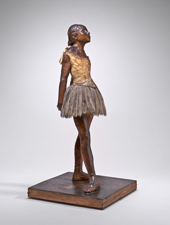Slippers
Degas used real ballet slippers, just as he had used a real bodice, and altered them to fit his dancer before coating them with wax. The slippers were made of finely woven, undyed linen (fig. 4),[6] suggesting that they were practice or children’s slippers to which Degas made several adjustments, as Lindsay discusses in the entry text below. To color the slippers pink, Degas coated the linen with wax pigmented with red lake, pink lake, chrome orange, chrome yellow, lead white, and charcoal black.[7] He cut an existing ribbon from across the instep and attached long cotton[8] ribbons at the backs of the shoes that were wrapped around the dancer’s ankles and tucked under at the back of her leg. Further proof that the slippers are real is the presence of the drawstrings, casually lying on the top toward the toe of the shoes. Degas even cut the toes and squared them to a shape similar to the unused, pink satin slipper discovered among his studio effects.[9] The fabric inset at the heel of the studio slipper closely matches the woven linen of the dancer’s pair as well.
Little Dancer Aged Fourteen
Technical Notes: Internal Construction
Technical Notes: Exterior Construction
Study in the Nude of Little Dancer Aged Fourteen (Nude Little Dancer)
Fourth Position Front, on the Left Leg
Technical Notes: Attire
Bodice
Upon completion of the wax figure, Degas dressed it as the young dancer.[1] For the bodice, he sought a manufactured garment, sewn in cotton[2] faille and tailored to the torso. That the bodice was tailored in situ to suit the dancer’s torso is suggested by the differing widths, loose seams, and skewed placement of the excess fabric gathered on the top edge of the bodice and below the left shoulder. Additional alterations are apparent under the dancer’s arms: on the right the garment protrudes slightly from the armpit, and on the left supplementary wax was employed to compensate for misalignment, possibly due to the manipulation of the shoulder strap.
To slip the bodice over the arms, its shoulder straps were cut. On the right side, the cut edges of the strap were sunk into the wax behind the button; on the left a band of wax used to adhere the two edges is present in front of the button. Once lifted over the head and slipped onto the torso, the bodice was buttoned. From the radiograph, it is evident that the buttons consist of metal casings, identified using XRF as zinc casings,[3] covered in fabric. Unpigmented beeswax, which serves to integrate the garment visually and physically with the sculpture, was applied to the entire bodice.[4]
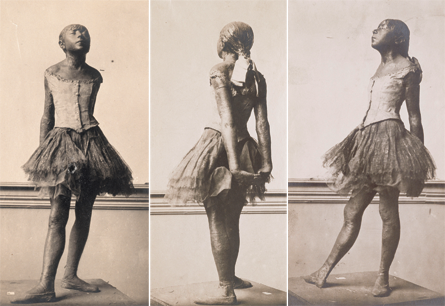
Figs. 1–3: Little Dancer Aged Fourteen, photographed by Gauthier for the 1917–1918 Durand-Ruel inventory, front, rear, and three-quarter view. Musée d’Orsay Paris. Photo © RMN-Grand Palais / Art Resource, NY. Photographer: Franck Raux
The bottom third of the bodice appears gray and wrinkled. Possibly when the tutu was removed for posthumous casting of the sculpture, the lower areas of the bodice were disturbed, breaking off the original wax in the process and creasing the fabric. Once a mold was executed, an attempt may have been made to straighten the bottom of the bodice, perhaps by adding hot paraffin wax.[5] This observation and the absence of these creases on the bodice in the inventory photographs (see figs. 1–3), coupled with their presence on both the National Gallery of Art’s plaster version and the serial bronzes, substantiate this hypothesis.
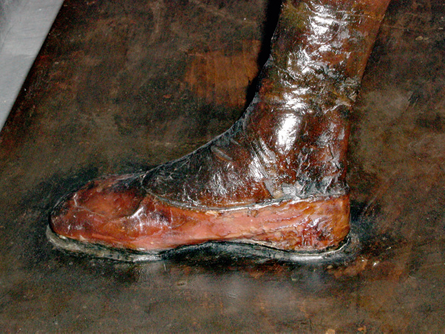
Fig. 4: Degas, Little Dancer Aged Fourteen, detail, showing slipper
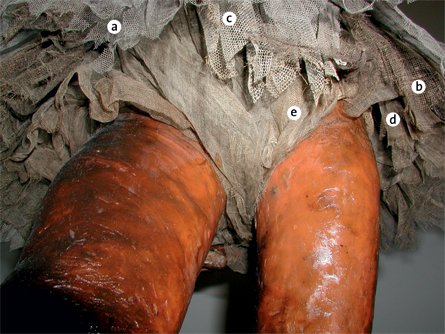
Fig. 5: The tutu on Little Dancer Aged Fourteen. a. Outermost layer, silk tulle with V-shaped triangular cut bottom; b. Second layer, cotton, plain weave, showing starch-filled cells; c. Third layer, front panel, silk maline net; d. Fourth layer, cotton filet net; e. Fifth layer, culottes, cotton, plain weave
Tutu
While the bodice appears to have been a manufactured garment, albeit adjusted to fit the sculpture, the multilayered tutu was most likely cut from netting and attached directly around the wax figure. The tutu assemblage consists of five layers of netting[10] or fabric, of varying degrees of coarseness and of slightly differing colors (fig. 5).[11] The most familiar, outermost layer (fig. 5a) is a pale, possibly once white, silk[12] tulle with hexagonal-shaped cells. It is gathered with large stitches of a double-strand, coarse thread and fitted around the dancer’s waist. The bottom edge of this layer is cut by hand into V-shaped triangular points resembling the effect of an edge cut with pinking shears but on a much larger scale.
Progressing from outer to inner, the second layer of tutu (fig. 5b) is an open, plain weave, cotton fabric of a light brown, neutral tone. A number of the square interstices are coated with starch, here used as a stiffener.[13] This layer is exceptionally brittle, perhaps aggravated by the starch. The bottom edge has frayed considerably, and very little remains at the front of the statuette.
Present only at the front, the third layer consists of a “dirty” white, possibly starched, silk[14] maline net, twisted in such a way that the mesh has diamond-shaped cells. It is gathered on a string and hangs in full, rounded pleats from the waist (fig. 5c). Similar to the outermost layer of the tutu, this panel is cut so that the bottom edge is in V-shaped triangular points.
The fourth layer (fig. 5d) is made from a light brown cotton [15] filet net with a square mesh. In addition to serving as a tutu skirt layer, some of this fabric wraps between the figure’s legs.
Layer five, the innermost layer (fig. 5e), is made from an open, plain weave, light brown, cotton fabric [16] similar to that of the second layer, but it is not used for an actual tutu skirt. This fabric hugs the figure’s lower abdomen and is carefully wrapped between the legs, serving as culottes for the dancer.
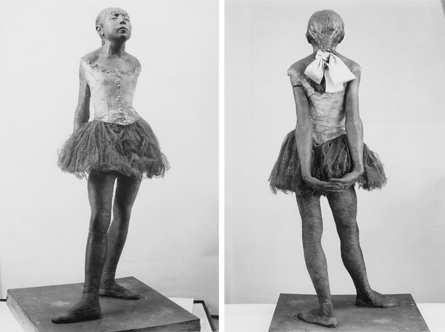
Figs. 6 –7: Little Dancer Aged Fourteen, photographs, late 1955 or early 1956, front and rear view. Mellon collection records, National Gallery of Art curatorial files, Washington
Careful analysis of the extant tutu layers together with inventory photographs (see figs. 1–3) and the 1955 / 1956 photographs (see figs. 6, 7) reveals some striking comparisons that suggest the tutu is the same as the one pictured in the inventory photograph. As no conclusive documentation has yet been discovered regarding an actual change in the sculpture’s tutu, and given its extremely fragile condition and numerous layers of different netting, the possibility still exists that the extant tutu is indeed the one Degas exhibited in 1881, with possible enhancements added over the years. By the time of Degas’ death, the outer layer of the dancer’s skirt was already short, close to the present length of the entire tutu assemblage, with large sections detached and hanging loose. In the inventory photographs, the bottom edges of both the top layer and the next visible layer appear to have V-shaped triangular points; today the first and third layers have the same kind of bottom edge. The second and fourth layers are much deteriorated and irregular, and by 1955 had been cut to the same length as the outer layer. Furthermore, the creases and wax drips visible on the tulle appear to be the same ones pictured in both the 1918 and 1955 views. According to Paul Mellon’s staff, the tutu was not changed after he purchased the collection.[17] As Lindsay describes in the discussion of historical issues in the entry text below, consideration was given to changing the badly deteriorated tutu but in fact this does not appear to have occurred. That there are five layers alternating between silk and cotton, both net and plain weave fabric, now all desiccated and brittle, speaks to the age of the fabrics and the tremendous amount of care Degas took to provide his dancer with realistic apparel. Neither the bronzes nor the plasters were given such elaborate tutu assemblages.[18]
Hair
Degas used a braided wig of human Caucasian hair[19] to coif his dancer, purchased perhaps from the doll-maker Mme Cusset.[20] Questions as to when the wax on top was applied, particularly given that Degas selected a real wig for her hair, have been raised repeatedly in the literature.[21] Examination of the tresses below the wax reveals that the hair color of the wig is in fact dark blond. Louisine Havemeyer recalled, “How woolly the dark hair appeared,” suggesting that already in 1903 dirt or wax darkened her hair.[22] Clearly Degas applied some wax over the hair as part of the original fabrication. In fact, analyses reveal that this wax is the same as that from the rest of the figure.[23] To attach the braid, it was wrapped in silk[24] ribbon inserted into a hollow at the back of the dancer’s head and held in place by squeezing wax around the bundle of hair at the nape of the neck. This bundle of hair may also have been wrapped in a grosgrain ribbon, an impression of which is visible in the soft wax.[25] As he did with the bodice, Degas used wax to integrate the garment visually and physically with the sculpture, fully manipulating the versatility of his medium. On the one hand, the wax formed part of the adhesive process of the hair. On the other, by tooling the wax to simulate hair on the top of the dancer’s head, the hair became visually blended into the sculpture.
Notes
1. Charles W. Millard, The Sculpture of Edgar Degas (Princeton, 1976), 39 n. 64, wonders whether “cassanet, fabr[icant] des poupeés habillées” may have been involved with dressing Little Dancer.
2. Michael Palmer, Analysis Report, March 29, April 17, 2002, NGA conservation files.
3. Barbara H. Berrie, Analysis Report, January 21, 2005, NGA conservation files
4. Suzanne Quillen Lomax, Analysis Report, January 4, 2004, NGA conservation files. The beeswax was extended with potato starch. No glue was detected in any of the analyses done of wax between the bodice and the figure, although Mary Cassatt observes (letter to Louisine Havemeyer, December 8, 1919, in Michael Pantazzi, "The Little Fourteen-Year-Old Dancer: cat. nos. 223–227," in Jean Sutherland Boggs et al., Degas, exh. cat. (New York and Ottawa, 1988), 351: “Casting it [Little Dancer] will be difficult because the bodice is glued to the statue.” The term “glued” may actually mean “adhered” and therefore does not imply the use of glue.
5. Suzanne Quillen Lomax, Analysis Report, January 4, 2004, NGA conservation files. In all analyses the presence of paraffin is associated with repairs and does not appear to be original material.
6. Michael Palmer, Analysis Report, March 29, April 17, 2002, NGA conservation files.
7. Ibid.
8. Ibid.
9. This slipper is now in the collection of the Musée d’Orsay, Paris. See Jill DeVonyar and Richard Kendall, Degas and the Dance, exh. cat. (New York, 2002), fig. 261.
10. Net is a mesh fabric made on Levers, bobbinet, or Nottingham machines by twisting yarns around each other. Nets include bobbinet, a fine, firm, hexagonal mesh made of cotton or rayon yarns; maline, a fine, open, diamond-shaped mesh made of silk or rayon; tulle, a fine, more closely textured, hexagonal mesh, made of silk or rayon; and filet net, square-spaced mesh resembling gauze weave with the threads locked at the corners. Zelma Bendure and Gladys Pfeiffer, America's Fabrics: Origin and History, Manufacture, Characteristics, and Uses (New York, 1946), 642; Grace G. Denny, Fabrics and How to Know Them (Philadelphia and London, 1923), 70 – 72.
11. Since the tutu is often reported as having been made of muslin (see, for example, Richard Kendall, "Tutu Wars," Art Newspaper 89 (February 1999), it is important to note that muslin is defined differently in the United Kingdom and the United States. British muslin is similar to American cheesecloth, a loosely woven, plain weave, cotton cloth. In the United States, muslin refers to a strong and heavy, plain white cotton fabric with little size, often used for sheeting. The second and fifth layers of the tutu resemble British muslin / American cheesecloth.
12. Michael Palmer, Analysis Report, March 29, April 17, 2002, NGA conservation files.
13. Ibid.
14. Ibid.
15. Ibid.
16. Ibid.
17. Eugene Howard, member of Paul Mellon’s staff, personal communication to SGS, February 25, 1991.
18. For a discussion of tutus, see Richard Kendall, Degas and the Little Dancer, exh. cat. (New Haven and London, 1998), 43; Sara Campbell, in Martine Kahane et al., "Enquête sur la Petite Danseuse de quatorze ans de Degas," 48/14: La Revue du Musée d'Orsay, no. 7 (Autumn 1998): 68 – 71; Delphine Pinasa, in Kahane et al., "Enquête sur la Petite Danseuse," 63 – 65.
19. Michael Palmer, Analysis Report, March 29, April 17, 2002, NGA conservation files.
20. Millard, Sculpture of Edgar Degas, 39 n. 64; Degas, notebook 34 (1880 – 1884), 228, in Theodore Reff, ed., The Notebooks of Edgar Degas, 2 vols., 2nd rev. ed. (New York, 1985), 1:142, at the very bottom, an address, page inverted: “Mme Cusset [Cussey]-cheveux / des poupé(es)/119 r[ue] St Denis.” Degas’ note is then followed by Reff’s comment: “Probably noted as a source for the false pigtail of the statuette Petite Danseuse de Quatorze Ans.”
21. For example, Kendall, Degas and the Little Dancer, 41.
22. Louisine W. Havemeyer, Sixteen to Sixty: Memoirs of a Collector, ed. Susan Alyson Stein (New York, 1993), 255.
23. Suzanne Quillen Lomax, Analysis Report, January 4, 2004, NGA conservation files, and Michael Palmer, Analysis Report, March 29, April 17, 2002, NGA conservation files, GC-MS, SEM-EDS, and PLM analysis. A dark layer of paint applied to the top of the head was found to contain the same pigments as those found in other wax samples throughout, with the addition of calcium carbonate and lead white, indicating that the paint is not original to the fabrication. Areas identified as “restored” were frequently toned with pigments containing calcium.
24. Michael Palmer, Analysis Report, March 29, April 17, 2002, NGA conservation files.
25. Because the extant ribbon is not grosgrain, impressions of this weave in the wax of the braid may reflect an earlier or even a second ribbon, tied at that point.
